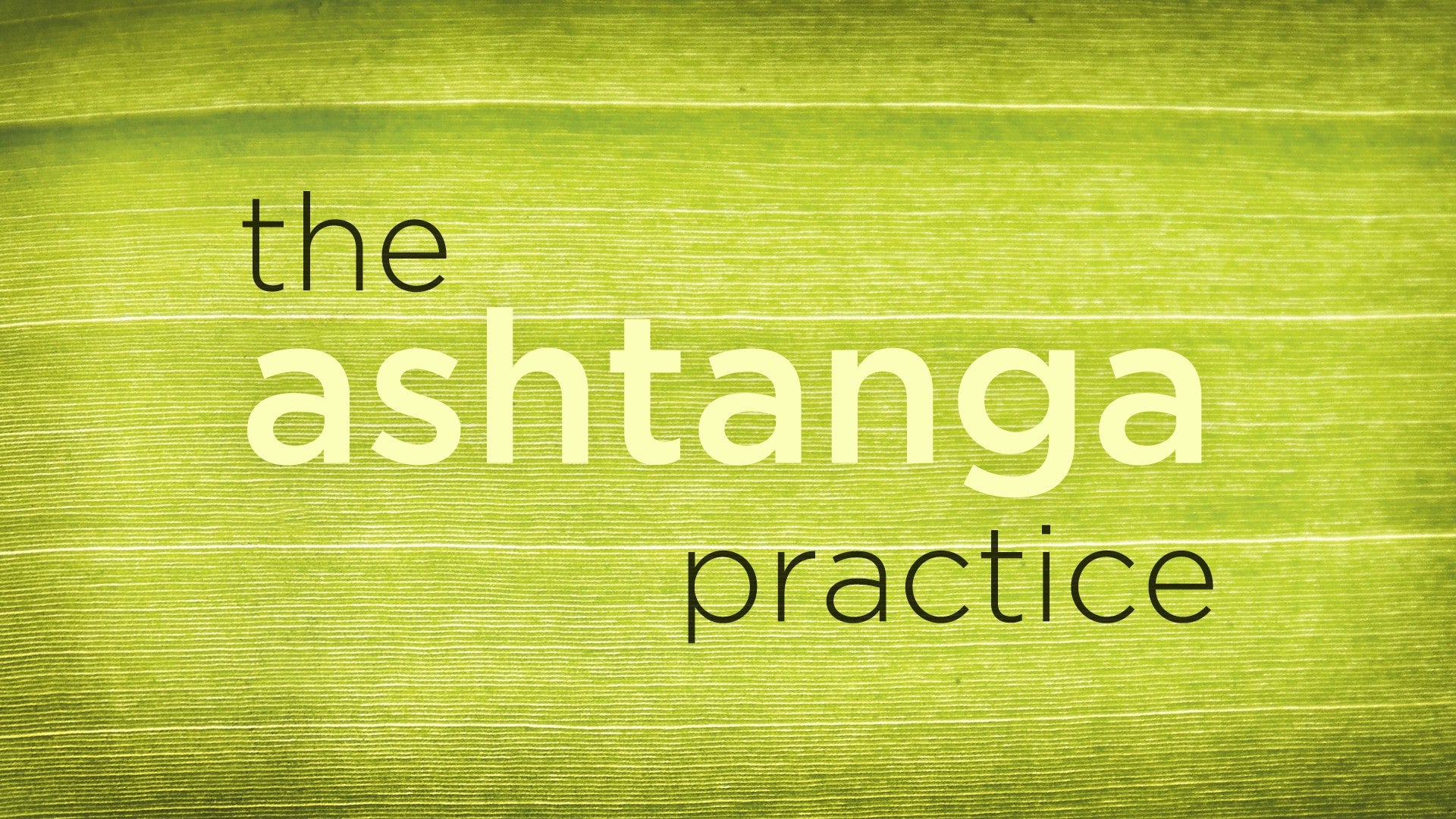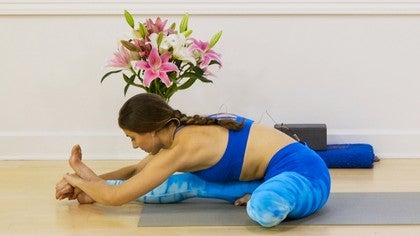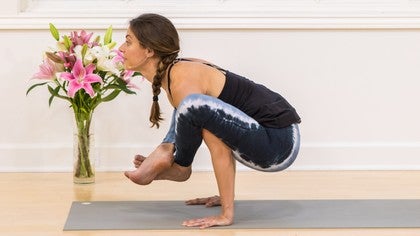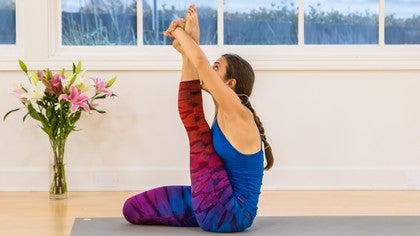Description
About This Video
Transcript
Read Full Transcript
Welcome back. Today we're going to be shooting a practice that's focused on opening up the hips for poses like lotus which are in the first series of ashtanga, but then we see them throughout the entire ashtanga practice. Focusing on different rotation than we use in second series or poses like suptakonasana This is more poses where the shin bone and the thigh bone are really close together. Because the muscles that we're opening we wind up opening up the feet as well because there's a connection. The fascia that encases the muscles goes all the way down to the feet.
A lot of times people's feet are really stiff and we need to open those especially as we go into lotus because lotus is done with a pointed toe. If you're used to running or hockey players who are wearing ice skates a lot the feet don't quite point or plantar flex enough. We'll start off with some foot stretches. You're going to need a block and possibly a couple blankets for today's practice. We'll just come to the front of your mat or anywhere and we'll start with our knees together and our feet together.
One thing I find is that it's really hard for some people to keep their ankles touching. If you are that person then you should strap your ankles together. We do want to keep the ankles together and the toes pointed so that we can really stretch the tops of the ankles. Depending on your flexibility in your feet, you may not be able to sit all the way back onto your heels so you can use blocks if you need to. You can keep your weight a little bit more forward and start to ease back.
If you're okay here you can just sit with your hands on your thighs. Or if you feel like you need a little more intensity you can take the hands back behind you and then start to lift the knees up. Deepening the stretch in the tops of the feet. Tops of the ankles and maybe even toes. The longer you can hold these the better.
Within reason of course. Just relaxing any tension in the shoulder, the jaws, the cheeks. Then we're going to switch foot positions so we'll lean forward, lift the hips up, curl the toes under. Spread the toes and now we'll be stretching the backs of the ankles. Again, this can be really tough for some of us.
The toes might be a little stiff. You may want to stay here just leaning forward a little more so there isn't as much weight in the feet. Or you can walk your hands onto your thighs and sit up onto your heels. Same thing here. If your ankles are starting to splay apart strap them together.
We really want to keep them close together. Then we'll just relax. If this isn't very much for you, you feel like you can go a little deeper then you'll take your hands out in front of you and you'll start to activate the pose a little by drawing your toes towards your shins and pressing out through your heels and maybe even lifting the knees up a little. Then it becomes a little bit more about stretching the Achilles which is also important especially it's hard to get the heels down in downward-facing dog or if pasasana is a difficult pose for you. Then we'll bring the knees down if you took them up.
Point the toes again, we'll do this one more time with the toes pointed. Ankles together. Then you can take the hands to the tops of the thighs and breathe. And again, if you'd like, you can take it a little deeper by leaning back and starting to lift the knees up off the floor. Once again, bringing the hands down to the floor, lift the hips up, curl your toes under.
And then either keeping the hands on the floor and the weight more forward or taking the hands to the thighs. Holding here and breathing. Then we'll come up to standing. Coming to the front of your mat, bring your feet together, hands to prayer position at the heart. Relaxing the shoulders down, but lifting the chest up.
Spread the toes. Start to engage the legs by lifting the knee caps up the thighs. Lengthen the tailbone down. Start to drop the front ribs down and in. Focus on the ujjayi breathing.
Inhaling and exhaling through the nose. Start to draw out the breath. Let the breath be long and deep. Then releasing the arms down alongside the body. Inhale, reach the arms up overhead.
Exhale, hinge at the hips and fold forward. Inhale, look up, lengthen. Either coming to fingertips, hands to shins or hands flat. Exhale, bend the knees, step back and lower all the way down to the floor. Point the toes, roll the shoulders down the back, lift the chest up.
Either stay with cobra for the first one or you have the option to go all the way up to upward-facing dog. Then exhale to downward-facing dog. One. First one, you might need to keep the knees a little bent. While the backs of the legs are opening up.
Two. If you want you can even peddle your feet side to side. Three. Four. And five.
Look forward and walk your feet to your hands. Inhale to look up and lengthen. Exhale and fold forward. Inhale, come all the way up to the top. And exhale, return to samasthiti.
Again. Inhale, arms reach. Exhale and fold forward. Inhale, look up, lengthen. Exhale, step or jump to chaturanga.
Inhale, upward-facing dog. Exhale, downward-facing dog. One. Two, press the roots of the fingers. Wrap the outer upper arms around towards your face.
Three, then push the hips up and back. Four, start to reach the heels down towards the floor as you press the tops of the thighs back. And five, look forward. step or jump your feet to your hands. Inhale, look up and lengthen.
Exhale and fold. Inhale, come all the way up to the top. And exhale, samasthiti. One more. Inhale, arms reach.
Exhale and fold. Inhale, look up, lengthen. Exhale. Inhale, upward dog. Exhale, downward dog.
One. Two. Three. Four. Five.
Looking forward. Inhale. Exhale. Inhale, all the way up. Exhale.
Surya namaskara B with modifications. Bend the knees, sit the hips back. Inhale, utkatasana. Exhale, fold forward. Inhale, lengthen.
Exhale to chaturanga. Inhale, upward dog. Exhale, downward-facing dog. First one we'll step the right foot forward. Bring the left knee down to the floor.
Inhale, come up into a low lunge. You can just interlace your fingers on top of the right knee and adjust your stance so that your right knee is over your ankle and doesn't go past the ankle. Relax your shoulders down. Just lunge to a point where you can still breathe, but you're finding some stretch your lift tip flexor or quad. If you feel like you can take this a little deeper we'll bring the left hand down to the floor and maybe bend the left knee and reach back with your right hand to grab a hold of the foot and that'll move the stretch a little bit deeper into the quad.
You may need to adjust your stance and lengthen, bringing the right foot forward a couple of inches. We'll hold here and breathe for a few breaths. Then we'll release that. Set the right hand down. Step the right foot back and lower.
Inhale to upward-facing dog. Exhale to downward-facing dog. We'll step the left foot forward. Bring the right knee down to the floor. Take the hands on top of the left knee.
Point the right toes back. Adjust your stance so that the left knee is over the ankle and then just sink into it. Continue to lift the front hip bones up. Lengthen the tailbone down. You can either stay here or bring the right hand down to the floor.
Bend the right knee. Grab a hold with your left hand. If this puts any pressure in the knee then go back to one of the other variations. Then releasing that side, setting the left hand down again and press back to plank and lower. Inhale, upward-facing dog.
Exhale back downward-facing dog. Then let's just step the right foot forward. Pivot the lift heel down. Inhale, we'll come up into a virabhadrasana I on the right side. We'll spend a few extra breaths here so just straighten the right leg a little.
Pull the right hip back. Left hip forward. Press the outer edge of the left foot down. Keep the left leg perfectly straight. Lift the chest, lift the gaze.
Then maybe bend a little deeper into the right knee. As you bend deeper into the right knee keep straightening the back leg more and more. Then we'll exhale and release. Set the hands, step back. And lower.
Inhale, upward-facing dog. Exhale. Downward-facing dog. Step the left foot forward. Pivot the right heel down.
Inhale, coming up. Then just backing out of it a little bit. Straightening the left leg so that we can really anchor the outer edge of the right foot down. Start squaring the hips by pulling the right hip forward, left hip back. They won't get perfectly square.
Keep the back leg straight as you can and then bend the left knee. That's one, lift the chest. Lift the gaze. Two. Three.
Four. And then release. Set the hands, step back. And lower. Inhale, upward-facing dog.
Exhale. Downward-facing dog. Breathing here. And to the exhale, look forward and step or jump. Inhale, lengthen.
Exhale, fold. Bend the knees, sit the hips back. Inhale, uktatasana. Exhale, samasthiti. Regular surya namaskara B.
Bend the knees, inhale. Exhale. Inhale, lengthen. Exhale, chaturanga. Inhale, upward dog.
Exhale, downward dog. Right foot forward, left heel down. Inhale, virabhadrasana II. Exhale, all the way to chaturanga. Inhale, up dog.
Exhale, down dog. Left foot forward, right heel down. Inhale. Exhale. Inhale, up dog.
Exhale. One. Two. Three. Four.
Five. Look forward, step or jump. Inhale, lengthen. Exhale, fold. Bend your knees, sit the hips back.
Inhale, utkatasana. Exhale, samasthiti. We'll take the hands to prayer position. Inhale and open to the right. Turn the right toes out, left toes in.
For utthita trikonasa put a soft bend in your right knee. Spin the right thighbone out from deep in the hip sockets so we're getting that external rotation and your knee will be pointing to your second toe. Then start to lift the knee cap up the thigh. Reach the arms up and as you exhale you'll draw your right hip back and fold out over your right leg. Hand can come anywhere along the shin.
You can also use a block outside the foot. Or hook the big toe. We'll reach the left arm up and over. That's one. Two.
Three. Four. Five. Inhale, we'll come up. Exhale, change sides.
Left toe is out, right toe is in. Again, keeping a slight bend in the knee to start, spin the left thighbone out from deep in the hip socket. Continue to press the less big toe mound. As you straighten the leg, but the knee will continue to point to the second toe so the leg isn't rotating in. We're externally rotating that thigh.
Inhale, arms out. Exhale, drop the left hip back as you fold into trikonasana. Hand to the shin. To the floor or a block outside the foot. Or the ashtanga variation, holding the big toe.
That's one. Two. Three. Four. Five.
Inhale coming up. Exhale. Take the stance a little wider. We're going to turn the right toes out. Left toes in.
Virabhadrasana II. Relax the shoulders. The shoulders will be squared to the side. But the hips are going to be at a slight angle so they're not going to stay completely square. Angle them ever so slightly.
Right thighbone again spins out from deep into the hip socket. Left leg perfectly straight. Press the outer edge of the left foot down. Inhale, arms up. Exhale, we'll bend deep into the right knee and you may need to adjust your stance.
If when you bend your knee goes past your ankle. Take your stance a little longer. Take a few breathes here. Relax the shoulders. Then we'll inhale straight into the right leg and we'll change sides.
Turn the left toes out, right toes in. Relax the shoulders. Shoulders squaring. Hips at a slight angle. Spin the left thighbone out from deep in the hip socket.
Inhale. Exhale, bend the left knee. Setting it over the ankle, so adjusting your stance as needed. That's one. Turn to look over the left hand.
Two. Three. Four. Five. Inhale, come up.
We'll go back to the first side. If you need to rest the arms in between, go ahead. Parsvakonasana Staying with that wider stance from warrior II. Inhale and then exhale, bend the right knee. Same actions.
We wrap the outer hip in. Start to point the right sitting bone towards the left thigh. Keep the left leg straight and this time you can either take the elbow to the knee and the left arm up and over or we have the option to bring the right hand to the floor on a block or hand flat next to the foot. Continue to straighten that left leg. Press the outer edge of the foot down.
Drop the tailbone. Reach it to your left heel and just press the right knee out enough that it stays centered over the ankle. That's one. Two. Three.
Four. Five. Press down. Inhale, come up. Exhale, we'll change sides again.
Left toe is out, right toe is in. Inhale, arms reach. Exhale, bend the left knee. Find your warrior II then hug the outer left tip in. Start to the lengthen the tailbone towards your right heel.
Keep your right leg straight. Then lengthen the left side body. Take the elbow to the knee. Right arm up over head. Or you have the option to take the left hand to the floor, outside the left foot.
Or onto a block. That's one. Keep straightening the right leg. Two, slightly press the left knee out. Three.
Four. Five. Inhale, come up. Exhale, we'll step to the front of our mats. Inhale, come reach the arms up over head.
Exhale, hinge at the hips and fold. Inhale, look up, lengthen. Exhale, back to chaturanga. Inhale, upward-facing dog. Exhale, downward-facing dog.
From downward-facing dog we're going to step or jump through to seated. For janushirasana A. We'll take the right leg back and this can be done with the right foot flat against the left thigh. We want to start to square the hips off towards the front so if we just take the hips open then we're not really taking the opportunity to open up that right hip. Start to square the right hip forward.
Then you can either keep the right foot to the left thigh will make this right knee come in a little bit. If you're looking for that 90 degree angle then you point the toe, reach the knee out, and then you keep squaring the hips. Now it's more like from your left hip to your right hip and then your right knee we have 90 degrees. Then we can find a deeper rotation in that right hip. The right thighbone rotating out in the hip socket.
We square ourselves off to the right leg. If this puts pressure in your knee then you're probably going to want to stay with the other variation and with your foot to your left thigh, if the knee is up here you may need to put a block underneath your knee, especially if it's hurting the knee at all. If you can try that variation, pointing the toe, reaching the knee out to the right, and I sometimes even hold my knee and I use my fingers to help rotate my thighbone out to create more space on the inside of the knee. As I reach forward. Then either staying upright or reaching for the left foot.
Exhaling to fold. Taking a few breaths here. Whatever expression of the pose you're in. Sometimes you can actually find more opening in the hip by staying upright. Then we'll inhale and come up and exhale, straighten the right leg out in front.
We'll take the left leg back. If you're folding the left foot to the right thigh you might need to place a block underneath your left knee. Still work on pulling the right thighbone back into the hip socket and squaring the left hip forward. Another option is to point the toe and look this is very much similar to half lotus, all right? The only difference is instead of closing that knee again we're choosing to reach it out.
The heel starts to come to the outside of the pubic bone then as we square we pull the right thighbone into the hip socket. The right hip slides back and the left hip starts to pull forward. You can either stay upright here. Sometimes I'll take my thumb or my fingers in between my shin and my thigh and I'll create a little more space inside the knee. As I'm creating that space I'll continue to pull the left hip forward and reach the left knee out.
There shouldn't be any pain or pressure in the knees and I feel nothing in my knees right now. It's all in the hip. We also have the option to take the hands to the foot. Inhale, lengthen. Exhale, fold.
Inhaling, looking up. Exhale, releasing. Then we'll straighten the leg. Maybe shake out your legs. We're going to take baddha konasana, but this time we're going to use a block so go ahead and grab a hold of your block.
We'll take the feet in. Both of them. Some of us might need to sit up here. If the knees are really high and you're feeling pressure in the knees, sometimes you'll get the queue to open up the feet. Might be too soon for you to do that.
Right now we're still working on opening up the hips. Once the knees drop down enough then the feet will naturally start to open up like a book. Before that you're just kind of working on opening up the feet and really the emphasis can be more on opening up the hips. You may need to sit up on a block here especially if there's pressure in the knees so you can lift yourself up onto a block or a blanket. Finding that place where there's a challenge and there's a little discomfort.
You're feeling something, but it's not overwhelming and certainly there's no pain. First we'll start just with baddha konasana so if the knees have dropped down and you can open the feet up then you'll just hold onto the feet. Inhale, lift the chest. Exhale, start to reach forward. The hips can get a little light here as we fold forward, keep the hips anchored.
Keep sending the sitting bones down towards the floor which really just means you're anchoring back with the bandhas. Then we'll inhale, come up. We'll take that slightly different. We have blocks. Any block will do.
You'll bring the block in between the feet so you can start with the smallest width and then you can work yourself out from there. Sometimes it can be helpful to bring the hands behind you. Scoot the hips forward. Keep lifting the lower back as you reach the knees out and you'll see that'll you access a deeper stretch. Here.
Continually reaching out through the inner knees. Then we'll release that. Put the blocks off to the side. You might need a blanket for the next one. Siddhasana.
You can sit up on the blanket. This is like a broken apart, opened up lotus. We close the knees and we take the knees out wide and just as we did in janushirasana A the heel comes outside of the pubic bone. Starting with my left leg this time, but we're going to do both sides. Then the right leg.
Knee goes out to the side and the right heel starts to go outside of the pubic bone. Then it's the tops of the feet that are kind of resting on the floor. This can be done with the hips propped up or if you don't need the blanket you can just do it on the floor. Maybe your knees won't be that far out to the side. Your heels may not be that out to the side.
They may be more crossed and center. That's okay. What we're working on here is starting to close the shin bone and the thighbone. Together. Reaching the knees out.
Creating space in the hips. You can use the hands behind you. If you'd like. Then we'll change sides. We'll do the right leg first this time.
Pulling the right knee back and out to the side. Keeping the shin bone and the thigh bone close together then pulling the left knee out to the side and maybe starting to bring the hips a little closer towards the feet. Reaching the knees out as we do so. I suggest just keeping the hands behind you so you can use that to support you. Then releasing that, just shaking out the legs again.
Then coming into lotus. First, half lotus. As you're coming into it, you point the toe now I mentioned before that we want from the inside of the knee to the big toe and the outside of the knee to the baby toe, we want that equally long. What happens sometimes is the foot starts to sickle. We don't want that to happen.
We want to keep the outer shin engaged. We reached the knee out to the side. Hold the ankle. I suggest letting the back round a little bit here. Especially if you don't quite have that opening in the hip.
It can be helpful to just let it round. Let everything relax. Sometimes if we hold things too rigid everything tenses up and we'll actually bring more pressure into the knee. Just let it relax. Let the knee reach out.
Take the heel in towards the navel. Then see if you can get the outer edge of the foot towards the hip crease. Maybe the knee doesn't go down all the way. It stays up here. Maybe it starts to reach down.
It's like the outer edge of the foot just fits perfectly into that hip crease. For some of us, it will be here, but this is the direction that we're working towards. Then once it's there you can reach the knee out just a little bit as you pull the left leg back. Again, pointing the toe. Let yourself round a little bit.
Reach the left knee out to the side. As you close the shin bone and the thigh bone. Really important to do that. Close the joint. Then bring the left heel and the left outer edge of the foot towards the right hip crease.
Then we have lotus. Sometimes, it's helpful to just work on half lotus so you can just take the right leg back and just keep the left foot on the floor and then you would switch. Take the left leg into half lotus and keep the right foot on the floor. Finding a place where your body can manage it and you're not doing any harm to your knees. In ashtanga we always fold with the left leg over top of the right.
From here we'll just make our way into savasana. We'll undo our lotus. Again just shake out the legs. Lie down on your backs. We'll turn the palms open to the ceiling.
Bring the shoulders onto your mat. Just let the belly relax. No longer holding the belly in. Letting the belly rise with inhalation. Fall with exhalation.
Relax any tension in the jaw or the cheeks. Soften through the neck and the shoulders. Then once you've decided you're in a comfortable position just enjoy it. Start to deepen the breath. Then bring small movements into the hands and feet.
Reach the arms up overhead. Bend your knees and roll over to your right side. Resting there as long as you'd like. Then press yourself up to seated. Thank you.
Namaste.
The Ashtanga Practice: Maria Villella
Comments
Suzanne
You need to be a subscriber to post a comment.
Please Log In or Create an Account to start your free trial.



















